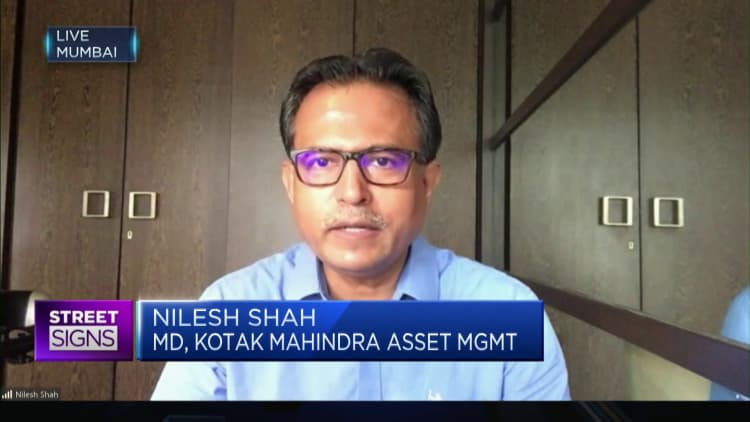Rice generation in India has fallen by 5.6% year on calendar year as of September in light-weight of under-normal monsoon rainfall, which has influenced harvest, Nomura said.
Rebecca Conway | Getty Visuals Information | Getty Photographs
India, the world’s biggest rice exporter, has banned shipments of damaged rice — a transfer that will reverberate across Asia, in accordance to Nomura.
In a bid to management domestic prices, the govt banned exports of broken rice and slapped a 20% export tax on many varieties of rice starting Sept. 9.
Nomura explained the impact on Asia will be uneven, and the Philippines and Indonesia will be most susceptible to the ban.
India accounts for approximately 40% of worldwide rice shipments, exporting to a lot more than 150 countries.
Exports reached 21.5 million tons in 2021. That’s much more than the total cargo from the following 4 most important exporters of the grain — Thailand, Vietnam, Pakistan and the United States, Reuters claimed.
But output has lowered by 5.6% calendar year-on-year as of Sept 2. in light-weight of down below-regular monsoon rainfall, which influenced harvest, Nomura explained.
For India, July and August are the “most vital” months for rainfall, as they identify how significantly rice is sown, said Sonal Varma, chief economist at the economical companies company. This yr, uneven monsoon rain styles for the duration of these months have minimized manufacturing, she extra.
Massive rice-generating India states these kinds of as West Bengal, Bihar and Uttar Pradesh are obtaining 30% to 40% significantly less rainfall, Varma mentioned. Even though rainfall increased towards the end of August, “the additional delayed the sowing [of rice] is, the larger is the threat that produce will be decreased.”
Previously this yr, the South Asian nation curbed wheat and sugar exports to manage mounting nearby charges as the Russia-Ukraine war sent world wide food items markets into turmoil.
Most influenced
The Indian government lately declared that rice creation throughout the Southwest monsoon time amongst June and Oct could slide by 10 to 12 million tons, which implies that crop yields could dip by as substantially as 7.7% year on 12 months, Nomura claimed.
“The impression of a rice export ban by India would be felt each instantly by nations that import from India and also indirectly by all rice importers, because of its affect on global rice charges,” according to a report by Nomura launched not too long ago.
Findings from Nomura revealed that the price of rice has remained high this year, with the maximize in selling prices in retail markets hitting close to 9.3% year on 12 months in July, in comparison with 6.6% in 2022. Client price tag inflation (CPI) for rice also spiked 3.6% 12 months-on-12 months as of July, up from .5% in 2022.
The Philippines, which imports a lot more than 20% of its rice intake wants, is the nation in Asia most at hazard of increased price ranges, Nomura stated.
As Asia’s greatest web importer of the commodity, rice and rice items account for a 25% share of the country’s food items CPI basket, the best share in the area, in accordance to Statista.
Inflation in the nation was at 6.3% in August, knowledge from the Philippines Data Authority confirmed — previously mentioned the central bank’s goal range of 2% to 4%. In light of that, India’s export ban would appear as an more blow to the Southeast Asian country.

Similarly, India’s rice export ban will be harmful to Indonesia as very well. Indonesia is most likely to be the second-most afflicted state in Asia.
Nomura claimed that the state relies on imports for 2.1% of its rice intake desires. And rice helps make up about 15% of its food items CPI basket, according to Statista.
For some other Asian countries, on the other hand, the pain is most likely to be nominal.
Singapore imports all of its rice, with 28.07% of it coming from India in 2021, according to Trade Map. But the region just isn’t as susceptible as the Philippines and Indonesia as “the share of rice in the [country’s] CPI basket is really little,” Varma famous.
Buyers in Singapore are likely to spend “a bigger chunk” of their bills on solutions, which ordinarily would seem to be the scenario for greater-cash flow nations, she explained. Low- and middle-revenue countries, on the other hand, “tend to commit an even greater proportion of their fees on food.”
“The vulnerability requires to be found from the viewpoint of both the effects on expenditure for shoppers and how dependent nations [are] on imported foods items,” she added.
Nations that will benefit
On the flip side, some nations could be beneficiaries.
Thailand and Vietnam will most likely to financial gain from India’s ban, Nomura reported. That is mainly because they’re the world’s second- and third-most significant exporters of rice, making them the most likely choices for nations hunting to fill the hole.
Vietnam’s complete rice generation was somewhere around 44 million tons in 2021, with exports bringing in $3.133 billion, in accordance to a report revealed in July by investigation firm Global Info uncovered.
Details from Statista confirmed that Thailand manufactured 21.4 million tons of rice in 2021, an increase of 2.18 million tons from the former calendar year.
With the enhance in exports, and India’s ban putting an upward strain on rice prices, the general worth of rice exports will enhance and these two international locations will advantage from it.
“Any one who’s now importing from India will be seeking to import more from Thailand and Vietnam,” Varma said.